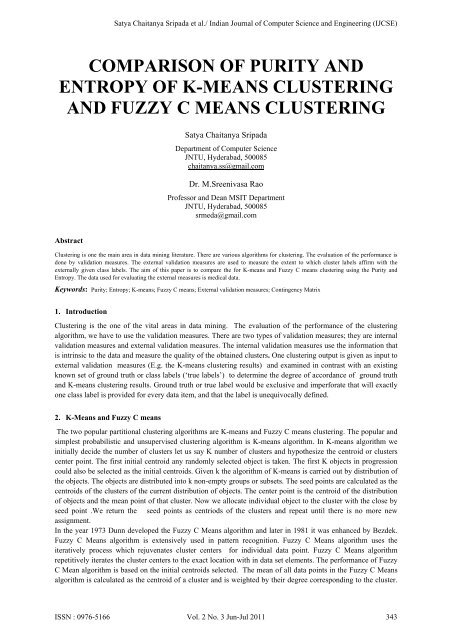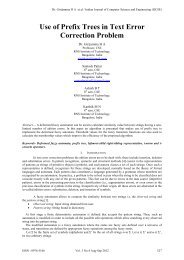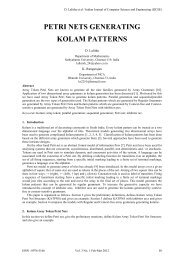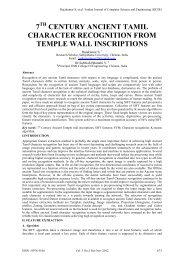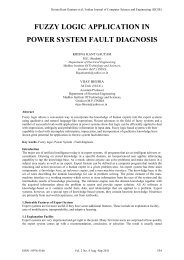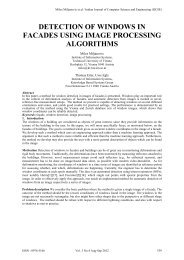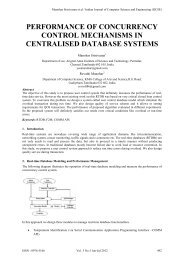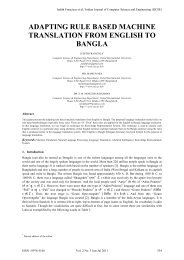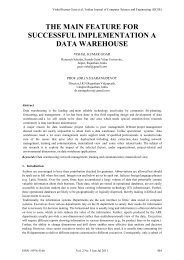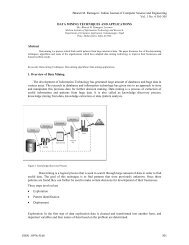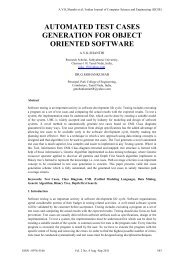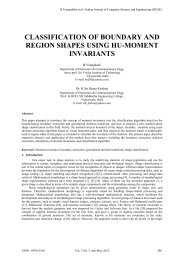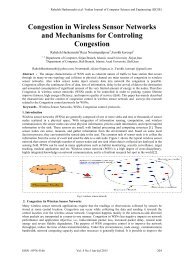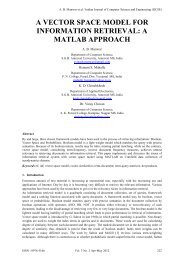comparison of purity and entropy of k-means clustering
comparison of purity and entropy of k-means clustering
comparison of purity and entropy of k-means clustering
Create successful ePaper yourself
Turn your PDF publications into a flip-book with our unique Google optimized e-Paper software.
Satya Chaitanya Sripada et al./ Indian Journal <strong>of</strong> Computer Science <strong>and</strong> Engineering (IJCSE)<br />
COMPARISON OF PURITY AND<br />
ENTROPY OF K-MEANS CLUSTERING<br />
AND FUZZY C MEANS CLUSTERING<br />
Satya Chaitanya Sripada<br />
Department <strong>of</strong> Computer Science<br />
JNTU, Hyderabad, 500085<br />
chaitanya.ss@gmail.com<br />
Dr. M.Sreenivasa Rao<br />
Pr<strong>of</strong>essor <strong>and</strong> Dean MSIT Department<br />
JNTU, Hyderabad, 500085<br />
srmeda@gmail.com<br />
Abstract<br />
Clustering is one the main area in data mining literature. There are various algorithms for <strong>clustering</strong>. The evaluation <strong>of</strong> the performance is<br />
done by validation measures. The external validation measures are used to measure the extent to which cluster labels affirm with the<br />
externally given class labels. The aim <strong>of</strong> this paper is to compare the for K-<strong>means</strong> <strong>and</strong> Fuzzy C <strong>means</strong> <strong>clustering</strong> using the Purity <strong>and</strong><br />
Entropy. The data used for evaluating the external measures is medical data.<br />
Keywords: Purity; Entropy; K-<strong>means</strong>; Fuzzy C <strong>means</strong>; External validation measures; Contingency Matrix<br />
1. Introduction<br />
Clustering is the one <strong>of</strong> the vital areas in data mining. The evaluation <strong>of</strong> the performance <strong>of</strong> the <strong>clustering</strong><br />
algorithm, we have to use the validation measures. There are two types <strong>of</strong> validation measures; they are internal<br />
validation measures <strong>and</strong> external validation measures. The internal validation measures use the information that<br />
is intrinsic to the data <strong>and</strong> measure the quality <strong>of</strong> the obtained clusters. One <strong>clustering</strong> output is given as input to<br />
external validation measures (E.g. the K-<strong>means</strong> <strong>clustering</strong> results) <strong>and</strong> examined in contrast with an existing<br />
known set <strong>of</strong> ground truth or class labels (‘true labels’) to determine the degree <strong>of</strong> accordance <strong>of</strong> ground truth<br />
<strong>and</strong> K-<strong>means</strong> <strong>clustering</strong> results. Ground truth or true label would be exclusive <strong>and</strong> imperforate that will exactly<br />
one class label is provided for every data item, <strong>and</strong> that the label is unequivocally defined.<br />
2. K-Means <strong>and</strong> Fuzzy C <strong>means</strong><br />
The two popular partitional <strong>clustering</strong> algorithms are K-<strong>means</strong> <strong>and</strong> Fuzzy C <strong>means</strong> <strong>clustering</strong>. The popular <strong>and</strong><br />
simplest probabilistic <strong>and</strong> unsupervised <strong>clustering</strong> algorithm is K-<strong>means</strong> algorithm. In K-<strong>means</strong> algorithm we<br />
initially decide the number <strong>of</strong> clusters let us say K number <strong>of</strong> clusters <strong>and</strong> hypothesize the centroid or clusters<br />
center point. The first initial centroid any r<strong>and</strong>omly selected object is taken. The first K objects in progression<br />
could also be selected as the initial centroids. Given k the algorithm <strong>of</strong> K-<strong>means</strong> is carried out by distribution <strong>of</strong><br />
the objects. The objects are distributed into k non-empty groups or subsets. The seed points are calculated as the<br />
centroids <strong>of</strong> the clusters <strong>of</strong> the current distribution <strong>of</strong> objects. The center point is the centroid <strong>of</strong> the distribution<br />
<strong>of</strong> objects <strong>and</strong> the mean point <strong>of</strong> that cluster. Now we allocate individual object to the cluster with the close by<br />
seed point .We return the seed points as centriods <strong>of</strong> the clusters <strong>and</strong> repeat until there is no more new<br />
assignment.<br />
In the year 1973 Dunn developed the Fuzzy C Means algorithm <strong>and</strong> later in 1981 it was enhanced by Bezdek.<br />
Fuzzy C Means algorithm is extensively used in pattern recognition. Fuzzy C Means algorithm uses the<br />
iteratively process which rejuvenates cluster centers for individual data point. Fuzzy C Means algorithm<br />
repetitively iterates the cluster centers to the exact location with in data set elements. The performance <strong>of</strong> Fuzzy<br />
C Mean algorithm is based on the initial centroids selected. The mean <strong>of</strong> all data points in the Fuzzy C Means<br />
algorithm is calculated as the centroid <strong>of</strong> a cluster <strong>and</strong> is weighted by their degree corresponding to the cluster.<br />
ISSN : 0976-5166 Vol. 2 No. 3 Jun-Jul 2011 343
Satya Chaitanya Sripada et al./ Indian Journal <strong>of</strong> Computer Science <strong>and</strong> Engineering (IJCSE)<br />
The degree <strong>of</strong> occurring in a specified cluster is related to the reciprocal <strong>of</strong> the distance to compute the weights<br />
<strong>of</strong> the cluster.<br />
3. Contingency Matrix<br />
The basis for the calculation <strong>and</strong> computation <strong>of</strong> these validation measures is the contingency matrix. This is the<br />
key area for these measures <strong>and</strong> is done by building the matrix <strong>and</strong> finding the values.<br />
Table 1<br />
S 1 S 2 S 3 … S K′ Σ<br />
D 1 n 11 n 12 n 13 … n 1K′ n 1·<br />
D 2 n 21 n 22 n 23 … n 2K′ n 2·<br />
D 3 n 31 n 32 n 33 … n 3K′ n 3·<br />
. . . . . . .<br />
D K n K1 n K2 n K3 n KK′ n K·<br />
Σ n·1 n·2 n·3 n· K′ n<br />
We have n objects in our data set Z <strong>and</strong> suppose that the partition D = {D 1 , ・ ・ ・ , D K } <strong>of</strong> Z, where D i ∩<br />
Dj = ϕ <strong>and</strong> U K i=1 D i = Z for 1 ≤i # j ≤K, <strong>and</strong> the count <strong>of</strong> clusters is K, it <strong>means</strong> there are K numbered<br />
clusters. Secondly for our data set Z we suppose that there is another partition S= {S 1 , ・ ・ ・ ,S K′ } <strong>of</strong> Z,<br />
where S i ∩ S j = ϕ <strong>and</strong> U K′ i=1 S i = D for 1 ≤ i # j ≤ K′ which constitutes the true class labels where count <strong>of</strong><br />
clusters is K′, it <strong>means</strong> that K′ numbered <strong>of</strong> class clusters exist. The n ij plays a very prominent role in our<br />
contingency matrix. This represents the count <strong>of</strong> objects present in D i cluster from S j class cluster, the data<br />
points that occur <strong>and</strong> the overlap between the D i cluster <strong>and</strong> Sj class cluster are counted <strong>and</strong> this count is written<br />
as the n ij in our contingency matrix. For suppose K =3 <strong>and</strong> K’ = 3 which <strong>means</strong> that there are 3 clusters in K-<br />
<strong>means</strong> <strong>and</strong> we have 3 class cluster we represent a three by three contingency matrix. The values <strong>of</strong> p ij , p i <strong>and</strong> p j<br />
are computed by pij = n ij / n, pi = n i· / n <strong>and</strong> pj = n·j / n.<br />
4. External Validation Measures<br />
To measure the quality <strong>of</strong> any thing we require an index. Quality is very essential characteristic <strong>and</strong><br />
distinguishing property <strong>of</strong> something. External validation is done class labels. Definition <strong>of</strong> the external<br />
validation indices: They are used to measure the extent to which cluster labels affirm with the externally given<br />
class labels. The class labels also known as ground truth are taken as base value. The external validation<br />
measures are extremely useful in deducing the ambit to which the <strong>clustering</strong> structure is ascertained by a<br />
<strong>clustering</strong> algorithm that matches some external structure. This is compared to the individual designated class<br />
labels. External validation measures criteria evaluate the final <strong>clustering</strong> output result with respect to a pre<br />
designated structure. For many applications these external validation measures are very much applicable. An<br />
illustration about the external validation measures exhibits that document <strong>clustering</strong> algorithm can pave to the<br />
results <strong>of</strong> <strong>clustering</strong> that match the distribution accomplishment by specialists.<br />
There are many external validation measures like Purity, R<strong>and</strong> Statistics, Entropy, Jaccard Coefficient, Mutual<br />
information, Fowlkes <strong>and</strong> Mallows Index, Minkowski score <strong>and</strong> Goodman – Kruskals Coefficient etc. We<br />
focus 3 external validation measures Purity, Entropy <strong>and</strong> F-measure. Here we discuss about the <strong>clustering</strong><br />
methods, Fuzzy C-Means <strong>and</strong> K-Means. The distance between various data points <strong>of</strong> the clusters generated by<br />
ISSN : 0976-5166 Vol. 2 No. 3 Jun-Jul 2011 344
Satya Chaitanya Sripada et al./ Indian Journal <strong>of</strong> Computer Science <strong>and</strong> Engineering (IJCSE)<br />
the algorithms is determined <strong>and</strong> analyzed. The clusters formed are evaluated <strong>and</strong> interpreted according to the<br />
distance between data points <strong>and</strong> cluster centers <strong>of</strong> each cluster. The determination <strong>of</strong> cluster quality is done by<br />
the <strong>purity</strong> <strong>and</strong> <strong>entropy</strong> measures.<br />
5. Purity <strong>and</strong> Entropy<br />
The K-<strong>means</strong> algorithm is implemented <strong>and</strong> the respective clusters are obtained. These clusters are compared<br />
with the true label data set <strong>and</strong> the values <strong>of</strong> Purity <strong>and</strong> Entropy calculated clusters generated by K-<strong>means</strong><br />
clusters <strong>and</strong> Fuzzy C <strong>means</strong>. The implementation is done in PERL. The Fuzzy C <strong>means</strong> is implemented <strong>and</strong> the<br />
respective clusters are obtained. The generated clusters are compared with the true label data set <strong>and</strong> the values<br />
<strong>of</strong> Purity <strong>and</strong> Entropy measures are calculated for the Fuzzy C <strong>means</strong> clusters. Purity is a one <strong>of</strong> very primary<br />
validation measure to determine the cluster quality. The <strong>entropy</strong> <strong>and</strong> <strong>purity</strong> are widely used measures. Entropy<br />
uses external information class labels in this case. The <strong>purity</strong> <strong>of</strong> the clusters is measured referencing to the class<br />
labels or ground truth is called as <strong>entropy</strong>. The lower <strong>entropy</strong> <strong>means</strong> better <strong>clustering</strong>. The Entropy amplifies<br />
when ground truth <strong>of</strong> objects in the cluster further diversifies. The greater <strong>entropy</strong> <strong>means</strong> that the <strong>clustering</strong> is<br />
not good. The quantity <strong>of</strong> disorder is found by using <strong>entropy</strong>. So we expect that every cluster should have low<br />
<strong>entropy</strong> to maintain the quality <strong>of</strong> our <strong>clustering</strong>. The <strong>purity</strong> is measured as Σ i p i (max j (p ij /p i )) where the values<br />
<strong>of</strong> pij , pi <strong>and</strong> pj are computed with respect to class labels. The <strong>entropy</strong> is measured as Σ i p i (Σ j (p ij /p i ) log (p ij<br />
/p i )) where the values <strong>of</strong> pij , pi <strong>and</strong> pj are computed with respect to class labels.<br />
Case 1 - Hepatitis<br />
External validation measures K-Means Fuzzy C Means<br />
Entropy 0.293299 0.289789<br />
Purity 0.383776 0.391036<br />
Case 2 - Diabetes<br />
External validation measures K-Means Fuzzy C Means<br />
Entropy 0.27078 0.251541<br />
Purity 0.230571 0.261304<br />
Case3 – Liver problem<br />
External validation measures K-Means Fuzzy C Means<br />
Entropy 0.302966 0.2993489<br />
Purity 0.7665034 0.7756013<br />
Case 4 – Heart disease<br />
External validation measures K-Means Fuzzy C Means<br />
Entropy 0.189828 0.1840025<br />
Purity 0.5671967 0.5961377<br />
Case 5 – Brain Tumor<br />
External validation measures K-Means Fuzzy C Means<br />
Entropy 0.298534 0.298373<br />
Purity 0.6456010 0.646002<br />
Case 6 –Eye lenses<br />
External validation measures K-Means Fuzzy C Means<br />
Entropy 0.2665893 0.2623207<br />
Purity 0.3301948 0.3358693<br />
ISSN : 0976-5166 Vol. 2 No. 3 Jun-Jul 2011 345
Satya Chaitanya Sripada et al./ Indian Journal <strong>of</strong> Computer Science <strong>and</strong> Engineering (IJCSE)<br />
6. Conclusions<br />
The greater the value <strong>of</strong> <strong>purity</strong> indicates good <strong>clustering</strong>. The <strong>entropy</strong> is negative measure, the lower the <strong>entropy</strong><br />
the better <strong>clustering</strong> it is. For the same data sets the Fuzzy C <strong>means</strong> <strong>and</strong> K-<strong>means</strong> algorithms were obtained <strong>and</strong><br />
the clusters were generated. The above indicated values show that the Fuzzy C Means has high value <strong>of</strong> <strong>purity</strong><br />
<strong>and</strong> low value <strong>of</strong> <strong>entropy</strong>. This indicates good <strong>clustering</strong>. The K-<strong>means</strong> has lower value <strong>of</strong> <strong>purity</strong> <strong>and</strong> high value<br />
<strong>of</strong> <strong>entropy</strong> compared to Fuzzy C Means. The Fuzzy C <strong>means</strong> <strong>clustering</strong> is more The Fuzzy C <strong>means</strong> <strong>clustering</strong> is<br />
more accommodating for medical data sets when compared to K <strong>means</strong>.<br />
References<br />
[1] Cao, X., Maloney, K.B. <strong>and</strong> Brusic, V. (2008). Data mining <strong>of</strong> cancer vaccine trials: a bird's-eye view. Immunome<br />
Research, 4:7. DOI:10.1186/1745-7580-4-7<br />
[2] Cheng, T.H., Wei, C.P., Tseng, V.S. (2006) Feature Selection for Medical Data Mining: Comparisons <strong>of</strong> Expert<br />
Judgment <strong>and</strong> Automatic Approaches. Proceedings <strong>of</strong> the 19th IEEE Symposium on Computer-Based Medical Systems<br />
(CBMS'06).<br />
[3] H. Xiong, J. Wu, <strong>and</strong> J. Chen. K-<strong>means</strong> <strong>clustering</strong> versus validation measures: A data distribution perspective. In KDD,<br />
2006<br />
[4] Health Grades, Inc. (2007). The Fourth Annual HealthGrades Patient Safety in American Hospitals Study.<br />
[5] Kou, Y., Lu, C.-T., Sirwongwattana, S., <strong>and</strong> Huang, Y.-P. (2004). 7. Survey <strong>of</strong> fraud detection techniques. In<br />
Networking, Sensing <strong>and</strong> Control, 2004 IEEE International Conference on Networking, Sensing <strong>and</strong> Control<br />
[6] Nightingale, F (1858). Notes on Matters Affecting the Health, Efficiency <strong>and</strong> Hospital Administration <strong>of</strong> the British<br />
Army.<br />
[7] Shillabeer, A (29 July 2009). Lecture on Data Mining in the Health Care Industry. Carnegie Mellon University<br />
Australia.<br />
[8] Michael Steinbach, George Karypis, <strong>and</strong> Vipin Kumar. A <strong>comparison</strong> <strong>of</strong> document <strong>clustering</strong> techniques. In Workshop<br />
on Text Mining, KDD, 2000.<br />
[9] Strehl, J. Ghosh, <strong>and</strong> R.J. Mooney. Impact <strong>of</strong> similarity measures on web-page <strong>clustering</strong>. In Workshop on Artificial<br />
Intelligence for Web Search, AAAI, pages 58–64, 2000.<br />
[10] S. van Dongen. Performance criteria for graph <strong>clustering</strong> <strong>and</strong> markov cluster experiments. TRINS= R0012, Centrum<br />
voor Wiskunde en Informatica. 2000.<br />
[11] Wu, H. Xiong, J. Chen, <strong>and</strong> W. Zhou. A generalization <strong>of</strong> proximity functions for k-<strong>means</strong>. In ICDM, 2007.<br />
ISSN : 0976-5166 Vol. 2 No. 3 Jun-Jul 2011 346


